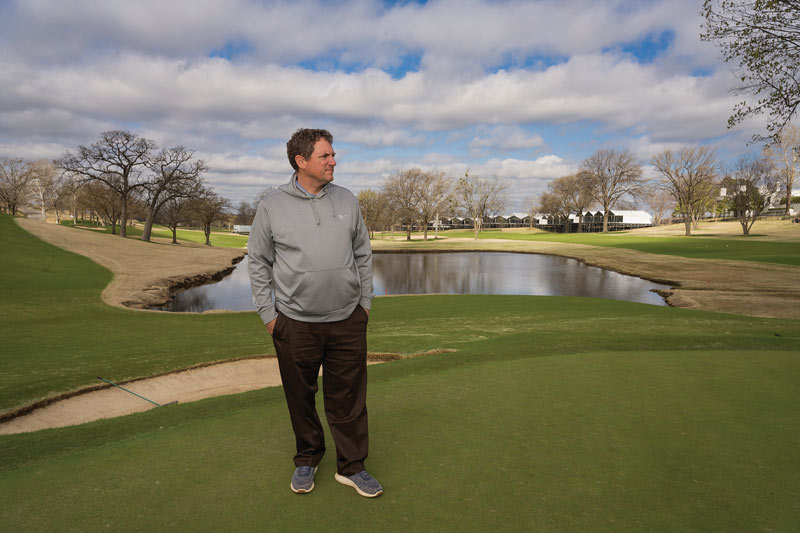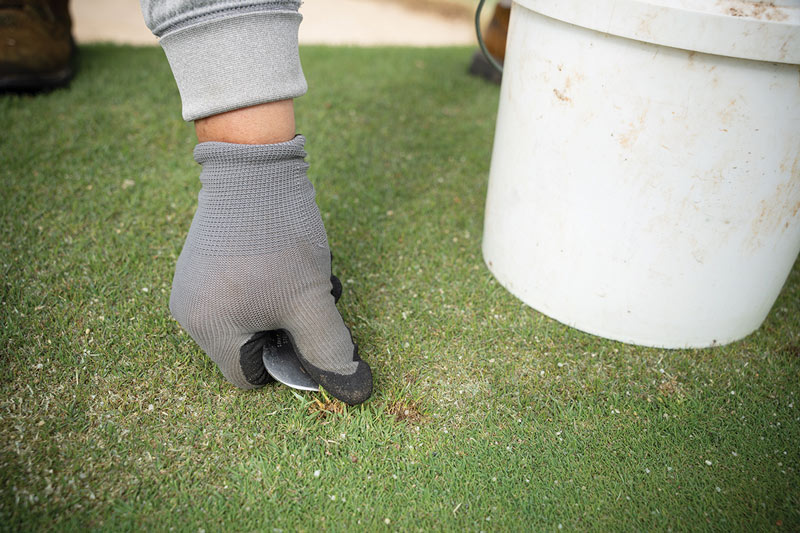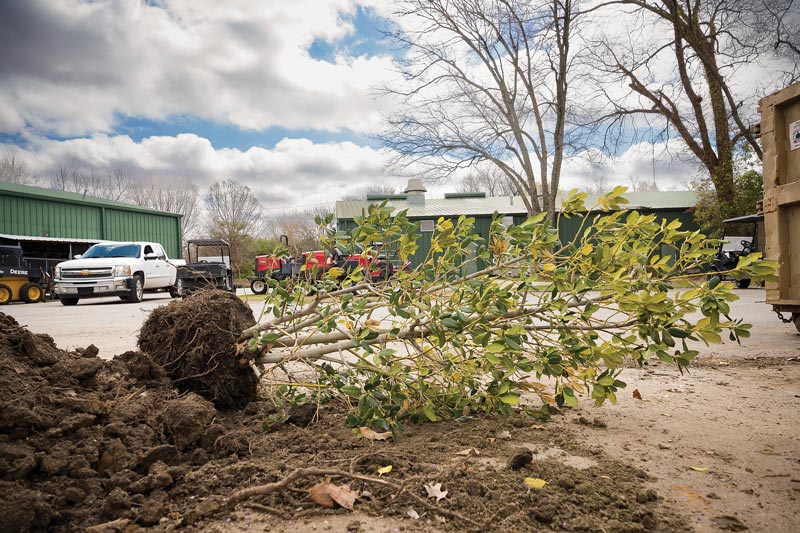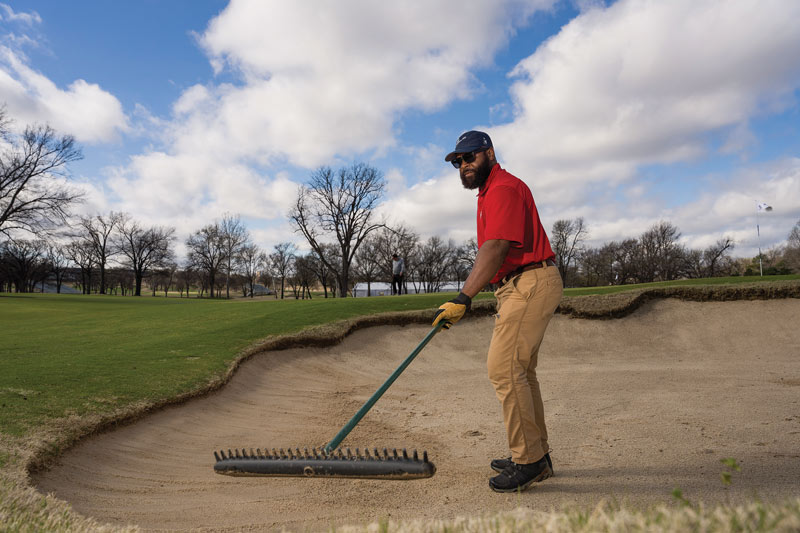
Southern Hills closed for 10 months to undergo a restoration of its Perry Maxwell-designed championship course. Photo by Gary Kellner
When Russ Myers left Southern Hills Country Club in 2010 for the top job at Los Angeles Country Club, few observers would have wagered on a return engagement in Tulsa, Okla. After all, the move to Southern California to oversee maintenance at the famed
club and run point on a project to restore its North Course seemed a natural next step on Myers’ high-flying, coast-to-coast career journey.
Born, raised and educated in upstate New York, Myers had spent time as an assistant-in-training at Augusta National, worked in the Florida Keys at Card Sound Golf Club, and successfully led preparations for the 2007 PGA Championship at Southern Hills
less than a year after taking the job there. He was also a “tournament junkie,” as good friend and mentor Matt Shaffer dubbed him, traveling the country to volunteer at well over 100 professional golf events during his career. Add it all
up, and Myers seemed destined to check at least a few more top-100 jobs off his list before calling it a career.
But when you watch Myers now as he makes his way around Southern Hills, well into the seventh year of his second stint at the club, you’re left surprised that he ever left in the first place. The 26-year GCSAA member knows everyone, and they know
him right back. He’s as comfortable dealing with the club’s top brass as he is the bartenders, waitstaff and clubhouse attendants. Southern Hills and Tulsa, it’s clear, are his home.
There were definite personal reasons behind his decision to return to Tulsa. His wife, Lindsay Patterson, is a Tulsa native, and the couple now have a family (daughter Grace and son R.J.) that they didn’t have when they first moved to Los Angeles.
“Like most people, I have a priority list, and my wife and kids are No. 1. The job is No. 2,” Myers says.
But the job is still a doozy that has plenty to offer someone like Myers. Southern Hills is one of the crown jewels of Midwestern golf, a fixture in Tulsa since its founding in 1936. Shortly after Myers’ return, the Perry Maxwell design underwent
a yearlong restoration by Hanse Golf Course Design, which Myers had worked with on the North Course restoration at LACC.
And then there was the chance to scratch that tournament itch once again with a host of big events on the docket, including the one that takes center stage this month, the 104th playing of the PGA Championship.
“I came back because I trusted the people that are running the club, and I honestly felt like this was a better opportunity for me and my family than the one I was leaving,” Myers says. “From day one, my résumé has said
that my goal is to manage classic, championship golf courses that provided me with unique opportunities. ‘Classic’ and ‘unique’ are the key words there. That’s what I try to embrace, and that’s what I’ve found
here. That’s why I came back.”
A long, strange trip
The 18 holes that will be the center of the golf world the week of May 16-22 bear only a passing resemblance to the layout that last hosted the PGA Championship in 2007. Credit that to the restoration work that brought back many elements of Maxwell’s
original work and the fact the 2007 event was played in August, with temperatures topping the century mark every day of tournament week, while this year’s will be in May. Preparing and contesting a tournament in the heat of an Oklahoma summer
presents a far different agronomic puzzle than a springtime event.
The real story, though, is how Southern Hills, Myers and his 54-person maintenance team (nearly 60 volunteers will join them for the PGA) got to this point and the trials and tribulations they faced along the way. It’s a tale of tragedy, triumph
and turf loss that has its origins in Myers’ move at the start of 2010 to Los Angeles, where work with Gil Hanse, Jim Wagner and Geoff Shackelford on the restoration of the North Course awaited.

Russ Myers is in the seventh year of his second stint as the golf course superintendent at Southern Hills CC in Tulsa, Okla. He previously worked there from 2006-2010. Photo by Ace Cuervo
That Myers would move west ostensibly just to participate in a project such as this one would surprise anyone aware of his general distaste for golf course construction work. After his first significant project during his time at Card Sound, Myers would
tell anyone who would listen, “I don’t care if I ever do one of those again.”
But he makes a clear distinction between construction work and what went on at LACC and, later, Southern Hills. “Anyone who has been through construction work knows the impacts that can have afterwards. Heck, you fix an irrigation leak, and you
can see that thing for years,” Myers says.
“What we did in LA and then here was not that. I’m still a novice, but I learned so much from working with Gil, Jim and Geoff about the architectural presentation, which gave me a broader understanding of the vision, of how what we were trying
to do with the playing surface related to the overall experience. That’s what I enjoyed.”
The work on the North Course — which will get its own major turn next June when it plays host to the 2023 U.S. Open — was completed in two phases and included work on fairway bunkers (completed prior to Myers’ arrival), fairway contours,
new greens that included the installation of subsurface hydronic piping and countless other touches intended to restore George Thomas’ original design.
The work clearly captured Myers’ imagination, Hanse says. “Most of our discussions were focused on architecture and what we were trying to accomplish with the look and the feel, the detail work we were addressing,” Hanse says.
“Jim and I just think the world of Russ ... and we appreciate how inquisitive and thoughtful he is about all this. He challenges us with concepts, ideas, and he requires good answers. And really at both places, he’s seen all the details, appreciated
the intricacies and just made our work better.”
Two for one
Despite perceptions to the contrary, Myers and Hanse were not a package deal when the former returned to Tulsa in 2015.
The club was in the market for a consulting architect at that time following the end of a long partnership with Keith Foster in that role. And it did have Hanse on its short list for a potential driving range and short game practice area project it was
considering. That, however, was the extent of it when Myers began his second round at Southern Hills.
Things began to accelerate when the practice area idea was put on the back burner in favor of a widespread master plan for the clubhouse. Myers gently pushed for a broader approach.


As Southern Hills CC began to wake up after winter dormancy, crews began final preparations for this month’s PGA Championship. Photos by Ace Cuervo
“I felt if we didn’t at least include a long-term look at the golf course at that same time, we were going to commit a lot of resources to the clubhouse over several years, and the golf course might get tabled for a long time,” Myers
says. “I just interjected the idea of having Gil give his thoughts on the golf course from a master plan standpoint as well, and they ultimately did that.”
Hanse says Myers’ role in cementing the relationship between Southern Hills and his design team can’t be overstated. “He was someone who went to the club and said, ‘Listen, I’ve worked with these guys at LACC, and that whole
process of researching and understanding the original design is what we should be doing here,’” Hanse says. “He became a big advocate for the plan.”
Originally, that plan focused on reshaping bunkers, recapturing fairway routings, removing trees to restore some of the property’s original sightlines and uncovering creeks that had been covered up over time. At that stage, work on the greens was
a consideration for another day.
But members soon warmed to the idea of adding a greens restoration to the menu, even if the new plan required the course to close, while the original one did not. One major disruption was better than two, the prevailing thinking went, especially when
a fully restored yet modern test of golf would be the end result.
Architecturally, the greens work focused on expanding the edges of the putting surfaces and a restoration of the roll-offs in those areas, creating effects similar to what you might find on the greens at Pinehurst No. 2. “Golfers who get anywhere
near the edges of the greens ... the ball is not going to stay on,” Hanse says. “I think the recovery options are going to be very interesting.”
The agronomic part of the work on the greens included grassing with Pure Distinction bentgrass and a hydronic system similar to the one installed at LACC that allows Myers and his team to use cold or hot water running through pipes to affect the temperatures
in the root zone. It’s a critical tool in the successful management of cool-season turf in a region known for its blistering hot summers.
“I was very open that I didn’t care whether the work on the greens was included in the original plan, but if they were, we needed to put in the hydronics,” Myers says. “My view on it was, if we went with ultradwarf (bermudagrass)
and maintained them to the level we would have to, we’d probably have as much risk of losing the bermuda from winterkill as we would the cool-season bentgrass to summer heat. Adding the hydronics to the mix made it an easy call.”
Winter woes
Southern Hills closed its championship course in August 2018 and underwent 10 months of work. Two years later, the new digs would get their first test of championship golf when they played host to the Senior PGA Championship, which would also serve as
a practice round for Myers and his team 12 months before this year’s PGA Championship.
The run-up to the event turned the situation into much, much more than just a dry run.
In mid-February 2021, Winter Storm Uri (as it was called by the folks at the Weather Channel) rolled across the continental U.S., bringing snow, ice and bitterly cold temperatures to parts of the country unaccustomed to such weather. The storm was blamed
for the widespread power crisis in Texas that left millions in the dark and significant turf loss and tree damage for more than a few Lone Star State superintendents.

Crew member Mitchell Cato preps a bunker at Southern Hills in early April, one of 54 full-time maintenance staff members who will be joined by 60 volunteers for the week of the PGA Championship. Photo by Ace Cuervo
Tulsa and Southern Hills were in the storm’s crosshairs, too, but the impacts there were not as dire. At least that’s how it appeared at first as Myers assessed the impact of the weather on his turf.
“I’d been through an ice storm here in 2008. We had snow or ice for 15 or 20 days and didn’t have any problems,” Myers says. “I probably thought we were bulletproof, or we’d just do whatever magical thing we did that
time, and we’d be OK. I’d never had any turf loss during my career. We just didn’t think much about it.”
They did remain vigilant, though. Throughout the month of March, with the course still mostly dormant and the weather staying unseasonably cool and overcast, Myers and his team periodically pulled turf samples to see how they’d react under grow
lights. They sought advice from sod growers, vendors and fellow superintendents. And through it all, they remained convinced that with time and a positive turn in the weather, they’d be fine.
Until, that is, early April rolled around, and Myers asked good friend Jeremy Dobson to stop by and offer his own take on the situation. Then the superintendent at The Patriot Golf Club in nearby Owasso, Okla., the late Dobson (see “Gone, but never
forgotten” on Page 35) was an assistant superintendent at Southern Hills during Myers’ first stint at the club. If there was anyone who could see something that Myers didn’t, it would be Dobson.
They checked out several spots on the course, and Myers awaited Dobson’s verdict. “I expected him to tell me that everything would be all right, but he didn’t,” Myers said. “He turned to me and said, ‘I know you don’t
want to hear this, but I’d be sodding this right now.’ I couldn’t believe it. I said, ‘You’d be sodding all this?’ and he said, ‘I’d be sodding a lot of it.’”
Dobson’s reasoning? “He said, ‘Right now, you’ve got nothing. If you leave it alone and you’re wrong, you’re done. If you start sodding now, at least you have something to work with,’” Myers says.
To test Dobson’s theory, Myers paid a visit to a nearby sod farm, where he shockingly found far more green grass than he was seeing at Southern Hills. That and a subsequent conversation with longtime Oklahoma superintendent Mike Wooten convinced
him that Dobson was right: Sodding was the only path to having playable turf for the Senior PGA.
After Myers notified club officials and Kerry Haigh, the PGA’s chief championship officer, crews got to work. For a month straight, they sodded from sunup to sundown, focusing mainly on fairways and areas around putting greens. All told, they sodded
just under six acres of turf. Early returns weren’t positive; Myers said three weeks out from the tournament, those areas remained effectively “unplayable.”
But a multipronged plan that included the use of covers, regular topdressing and strategic fertilization — not to mention a long-overdue break from Mother Nature — eventually paid off with green grass and more-than-playable conditions for
the Senior PGA. “I’d never been through anything quite like that,” Myers says, “but what these guys did was a pretty amazing accomplishment.”
Haigh, whose relationship with Myers goes back to that first PGA in 2007, couldn’t agree more. “Russ and his team did an unbelievably great job in preparing the course with all of those challenges,” Haigh says. “He is an expert
in the field of agronomy, extremely knowledgeable of the grasses and what it takes to bring out the very best in the golf course.”
The value of ‘coach speak’
If Myers, 49, hadn’t found his life’s calling as a superintendent, chances are he’d be on the sidelines coaching basketball.
It would have been a career choice that he came by naturally. His dad was a high school basketball coach and athletic director. While enrolled in the two-year turf program at State University of New York, Cobleskill, the younger Myers served as a student
assistant coach for the men’s basketball team there. He even considered pursuing graduate assistant coaching positions after college before landing his first job in golf.

Myers and Roy Bradshaw (left), Southern Hills’ equipment manager, study one of the creeks on the property that were uncovered during the restoration work at the club guided by Hanse Golf Course Design. Photo by Ace Cuervo
He still loves basketball and admits to studying the habits of those who patrol the sidelines. He’s even met and spent time with several big-name college coaches, including the head coach of this year’s NCAA national champs, the University
of Kansas’ Bill Self. It shouldn’t come as a surprise, then, that those who know him best say you’ll see as much coach in him as superintendent during this month’s PGA Championship.
“He approaches the job like he’s a coach and emphasizes the team concept and the value of everyone’s contribution,” says Chris Wilson, the director of agronomy at Los Angeles Country Club who took over that role following Myers’
return to Tulsa and was an assistant at Southern Hills during Myers’ first shift there.
“Nothing is ever off the table for Russ; if it needs to get done, he’s going to try to figure out how. He takes every thought, every opinion into consideration. That doesn’t mean he’s always going to agree with you, but he’s
going to consider it, evaluate it and make the best call possible.”
Myers knows the superintendent-as-coach notion is a bit of an industry cliché, but he doesn’t argue that, in his case, it’s appropriate. His top lieutenants at Southern Hills — including assistant superintendents Blake Willems,
Doug Cocanour and Robert Frizzell, and equipment manager Roy Bradshaw — would be the first to agree with that, and Myers says he’ll fully embrace it when the world’s best golfers once again visit Southern Hills this month.
“I’m always amazed at how those big-time coaches operate and what they can get out of their teams,” Myers says. “I think they’re good examples for superintendents. I know the coaching analogy isn’t a new one, but it
does make you think about how you react to situations, what kind of message you send.
“I want guys who will listen to you and follow you because they’ve bought in, they’re interested and they know you want what’s best for them and the golf course, not guys who are just listening because you happen to be the guy
up front talking to them or the one getting all the attention. That’s what I’ll try to instill in our crew for the PGA.”
Gone, but never forgotten

Even all these years later, Russ Myers swears you can still find Jeremy Dobson’s fingerprints all over the championship course at Tulsa’s Southern Hills Country Club.
“It’s been something like 12 or 14 years since he was here, but when I go out there, I can show you on almost every hole something that was impacted by him or that he was involved with,” says Myers, Southern Hills’ golf course
superintendent, about Dobson, who moved on to build and oversee maintenance at The Patriot Golf Club in nearby Owasso, Okla.
When Myers first came to Southern Hills in 2006, he became fast friends with the assistants there, Dobson and Chris Wilson. They quickly became Myers’ confidants, his sounding boards and his agronomic consultants, even after Dobson left for The
Patriot in 2008 and Myers moved west to Los Angeles Country Club at the start of 2010 (Wilson would later follow him there, and now serves as LACC’s director of agronomy). Myers and Dobson rekindled their friendship when the former returned
to Southern in late 2015, and Dobson figured to be front and center this month when major championship golf returned to Tulsa in the form of the 2022 PGA Championship.
Regrettably, life’s sometimes-cruel twists mean that won’t happen. Dobson, 48, died in a car accident on Feb. 21 on his way home from a trip to the Daytona 500, and Myers, The Patriot GC family and the entire Oklahoma golf community have been
grieving ever since.
“There wasn’t anybody better at what he did,” Myers says. “People loved working for him, and he always got the most out of them. He had instant credibility with them because he was going to be in there with you, doing the same
things he asked you to do. And there was nothing about him that was phony, not a damn thing.
“There’s some of us out here who get a ton of exposure at times in our careers for the events we host or whatever. Jeremy absolutely deserved that kind of recognition, but he was the type who would decline even taking the time to do an interview
or a public-speaking engagement. He always said he had his vector and wanted to stay in it. He was just a quintessential old-school soul.”
As such, Dobson would almost certainly not have much use for the memorials planned in his honor around the Southern Hills’ maintenance facility during the week of the PGA. Myers admits to struggling with how to recognize Dobson appropriately: “As
much as he means to me, he would never want him to be the focus of a PGA Championship.”
Ultimately, Myers settled on providing lanyards featuring a wish-you-were-here message for the full-time staff and volunteers working the event. He also noted a memorial scholarship established in Dobson’s honor at his beloved alma mater, Kansas
State University, by The Patriot GC, and says he’ll take time during the week for his own quiet, personal reflections.
The remembrances will be low-key, just the way Dobson would have wanted it. But that doesn’t mean the hole left by his absence won’t be deeply felt during the third week of May.
“He was a special guy, and there’s a lot of us who were fortunate to know him,” Myers says. “It just sucks that we won’t get to see him again.”
Scott Hollister is GCM’s editor-in-chief.